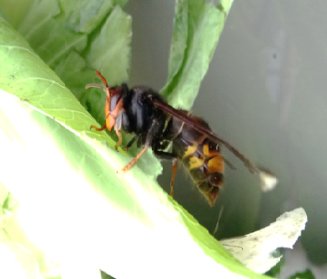Asian Hornet Identification
Try our quiz intended to help you recognise Yellow Legged Asian Hornets and to ensure you know what to do if you should see one.
Each time you try the quiz it will give you a different mix of questions.
Congratulations!! You obviously have a good knowledge of how to identify Asian Hornet, and what to do about it if you do find one. Please be vigilant during the summer months and use your knowledge to help keep all our bees safe. Ooops! If you scroll down the page, you can see the correct answers and an explanation for those which were not correct. You can find more information about Asian Hornet at the National Bee Unit website Beebase. Why not take a look and then come back and have another go at our quiz. It is important that all beekeepers can identify the Asian Hornet quickly and accurately if we are going to keep our bees safe. If possible sightings should be reported through the Asian Hornet Watch Application, available for free download to Android and iPhone mobiles. Other methods of reporting the hornet include using the NNSS online notification form or you can send any suspect sightings to the Non Native Species email address alertnonnative@ceh.ac.uk Where possible, a photo, the location of the sighting and a description of the insect seen should be included. This is the infamous ‘cauliflower hornet’ found by a homeowner in Bury, Lancashire in April 2018. Asian Hornets will defend their nests vigorously. Do not approach any nest you may find. Report the nest location using the Asian Hornet Watch application. If possible, include a photo of the nest or any flying insects. Three of the photos are of Asian Hornet nests. The fourth is a European Hornet nest. The nests are similar in appearance, especially from a distance. Asian Hornets are between 25 – 30mm long It is important that beneficial insects are not trapped and killed while monitoring for the presence of Asian Hornet. At this stage of hornet invasion into the UK, if thousands of killing traps were set across the country, then the damage caused by the traps would be far greater than the damage being caused by the Asian Hornet. This photograph shows the comparative size of the three insects. On the left, a common wasp queen, in the centre an Asian Hornet and on the right a European Hornet. The media often report Asian Hornet stories incorrectly with a photo of the Giant Asian Hornet shown below When monitoring for the presence of Asian Hornet using a trap, it is important that the trap does not kill any beneficial insects. The trap shown as the correct answer includes a mesh to prevent the trapped insects drowning in the bait. Even with this type of trap, it is important that it is checked on a daily basis and any beneficial insects are released safely.
Results


TRY THE QUIZ AGAIN
#1. What is the preferred way to report a possible sighting?

#2. Identify the insect in the photo
?
Photo courtesy The Animal and Plant Health Agency (APHA), Crown Copyright
#3. What should you do if you find an Asian Hornet nest?
#4. Which of the following is NOT an Asian Hornet nest?
?
Photos courtesy The Animal and Plant Health Agency (APHA), Crown Copyright
#5. How long is an Asian Hornet worker (head to tail)?
#6. In addition to catching Asian Hornets, what is most important about the use of a monitoring trap?
#7. Select the answer which lists Asian Hornet, Wasp, and European Hornet in terms of size (Longest first)


#8. What colour is the Asian Hornet’s abdomen?
#9. Which type of trap is recommended for Asian Hornet monitoring?
?
Photo courtesy The Animal and Plant Health Agency (APHA), Crown Copyright
#10. What colour are the Asian Hornet’s legs?
You can find out more about Yellow Legged Asian Hornet HERE or on the National Bee Unit website.
